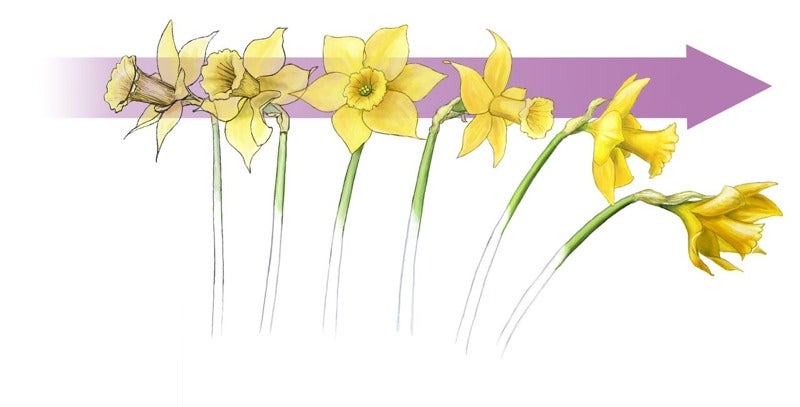 Daffodils have a special structure that reduces drag. photograph: Sally J. Bensusen/visible Science Studio, bensusen@visualsciencestudio.com. Used with permission.
Daffodils have a special structure that reduces drag. photograph: Sally J. Bensusen/visible Science Studio, bensusen@visualsciencestudio.com. Used with permission. The catastrophic collapse of Washington State's Tacoma Narrows Bridge in 1940 launched intensive analysis into the aerodynamics of bridge design. Now a team of South Korean scientists have identified a geometrical constitution that may more desirable stand up to the advanced aerodynamic forces at play—and that they discovered their suggestion in the form of a daffodil stem.
When wind flows across a protracted object, like a daffodil stem, it sheds little eddies of wind alongside both sides, with a small vortex of low pressure forming in the wake. The technical time period is "von Karman vortex shedding." Stick your arm out the window of a relocating motor vehicle and you can feel these oscillating side forces in motion. you can also see the impact readily by way of losing a sheet of paper to the ground. it will sway from side to side as it falls, and every sway is a vortex being shed.

 GIF
GIF Physicists from Seoul country wide school and Ajou institution in South Korea noticed that daffodil stems have a twisting pass-section shaped just a little like a lemon. by hook or by crook this unique constitution enabled the flower to show away from effective winds, to more suitable offer protection to its petals. the usage of laptop simulations of equivalent geometric constructions, the scientists found that the daffodil form stopped the vortex shedding, removing these nasty aspect-drive fluctuations. This, in turn, reduced standard drag by as a good deal as 23 p.c, compared to a round cylinder. They described their work in a recent paper in Physics of Fluids.
advertisement
Vortex shedding played a key position within the cave in of the Tacoma Narrows Bridge. in all probability you've heard it needed to do with a phenomenon called forced resonance: the wind matched the bridge's herbal resonant frequency, gaining power with each undulation until it broke aside. That's the explanation I heard lengthy ago, too, but scientists have on account that learned otherwise. (Even the press unlock for this new paper repeated the myth.)
The vortex shedding is what led to the bridge to "gallop," undulating up and down in line with excessive winds—therefore its nickname, "Galloping Gertie." And it's authentic the winds had been better that day in November, and therefore the undulations were that a lot larger. but neither wind nor undulations ever approached the herbal resonant frequency of the bridge, based on Frederick Burt Farquharson, an engineer at the tuition of Washington who became a part of the investigation into the fall down.
subsidized
however, these undulations eventually did trigger one of the crucial suspension cables to snap, growing an imbalance. The now-lopsided bridge all started to twist alongside its center axis, as well as undulate, emitting a shrieking metallic wail in the procedure. It was this new move that proved to be its undoing. The actual offender turned into whatever thing referred to as aerodynamically brought about self-excitation, or "flutter." It's a self-sustaining vibrational remarks loop, in essence.
whereas forced resonance is highest quality exemplified with the aid of an opera singer shattering a wine glass together with her voice, Motherboard's Alex Pasternack likened flutter to an amp that shrieks whenever it receives too near the microphone. (For any one interested in all the gory engineering particulars, Pasternack's prolonged examination is a have to-read.) That sort of feedback can also be cool when used sparsely with the aid of rock musicians, however let the remarks construct up too a great deal, and eventually you'll blow out your audio system.
That's essentially what took place to the Tacoma Narrows Bridge: each time the bridge twisted alongside its middle axis, it accelerated the impact of the wind as an alternative of dampening it, with ever-larger vortices shedding off its edges. The feedback kept building and constructing in power, unless sooner or later Galloping Gertie twisted itself aside.
commercial
This doesn't detract from the Korean scientists' paper's leading takeaway: for you to get rid of vortex shedding and significantly reduce drag through employing a twisty, helical shape when designing an object.
The daffodil's peculiar geometry isn't mainly smartly-acceptable for bridge design, and hence would not have saved Galloping Gertie. however better knowing of those aerodynamic forces will lead to stronger bridge designs in the future. And co-writer Haecheon Choi said he and his colleagues have already got a patent for a daffodil-inspired golf membership. an identical ideas may also be utilized to issues like antennae, lampposts, chimneys, and skyscrapers—all of which could benefit from superior aerodynamical design.
[Physics of Fluids]
http://gizmodo.com/this-is-why-yo...
 here is Why You every now and then Get Chatter to your Tibetan Singing Bowl here is Why You now and again Get Chatter in your Tibetan Singing Bowl here's Why You sometimes Get Chatter in your Tibe
here is Why You every now and then Get Chatter to your Tibetan Singing Bowl here is Why You now and again Get Chatter in your Tibetan Singing Bowl here's Why You sometimes Get Chatter in your Tibe Tibetan singing bowls are commonplace for his or her soothing harmonic tones, most suitable for meditation. however they… examine extra read more
0 comments:
Post a Comment